Please scroll down for English version.
Nach einer gefühlten Ewigkeit hat am 15. Mai 2019 das Buchstabenmuseum zum ersten Mal seine Tore wieder geöffnet. Nicht zuletzt dank der großartigen Unterstützung vieler Freiwilliger, die in den letzten Wochen und Monaten beim Buchstabenputzen und weiteren Aufgaben tatkräftig Hand anlegten, konnte uns das Team vom Buchstabenmuseum für die Maiausgabe des Typostammtischs einen Tag vor der offiziellen Eröffnung seine einmalige Location bieten.
Nicht nur der Ort war diesmal exklusiv, auch der Termin hatte einen besonderen Stellenwert: In vielen vergangenen Jahren fand im Mai die TYPO Berlin statt; nun (und hoffentlich für viele kommende Jahre) hat sich das Festival Berlin Letters um den nun leeren Primetime-Spot gekümmert. In guter Tradition fand der Typostammtisch am Vorabend als Auftakt statt.
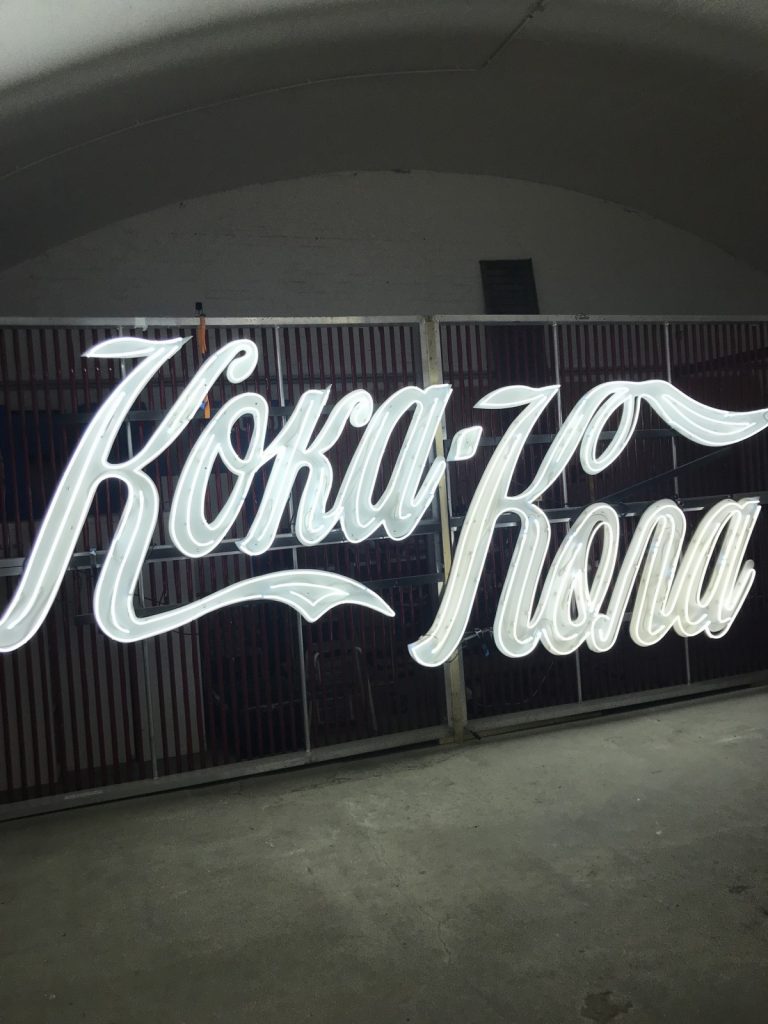
Trotzend den etwas frischen Temperaturen, die in den Hallen des Buchstabenmuseums in den S-Bahn-Bögen in Moabit kaum angenehmer wurden, fanden sich an diesem Abend gut 70 Gäste ein – genau so viele, dass alle einen Sitzplatz fanden und die Auslastung des Gewölbes ideal war. Für den anstehenden Vortrag des Abends fanden wir uns in der hintersten der Hallen ein; so konnten alle auf dem Weg dorthin zuerst am Eingang die riesige Leuchtröhrenwand mit der kyrillischen Ausführung des Coca-Cola-Schriftzugs bewundern und sich dann durch die riesige Sammlung genüsslich ihren Weg bahnen: vorbei an altbekannten Buchstaben, bei deren Anblick man sofort in Nostalgie schwelgt, Schriftzügen, deren Zugehörigkeit man erst auf den zweiten Blick erkennt, aber auch allerhand Kuriositäten und kleinen Schätzen der Berliner Buchstabengeschichte. Stimmungsvoll sind vereinzelt die Neonröhren sogar in Betrieb, sodass hier und da Buchstaben in der Dunkelheit leuchten und zur ohnehin magischen Atmosphäre beitragen. Kurzum, eine nicht endende Quelle an Inspiration für uns alle. Hinten angekommen, wartete die eigentliche Veranstaltung auf uns.
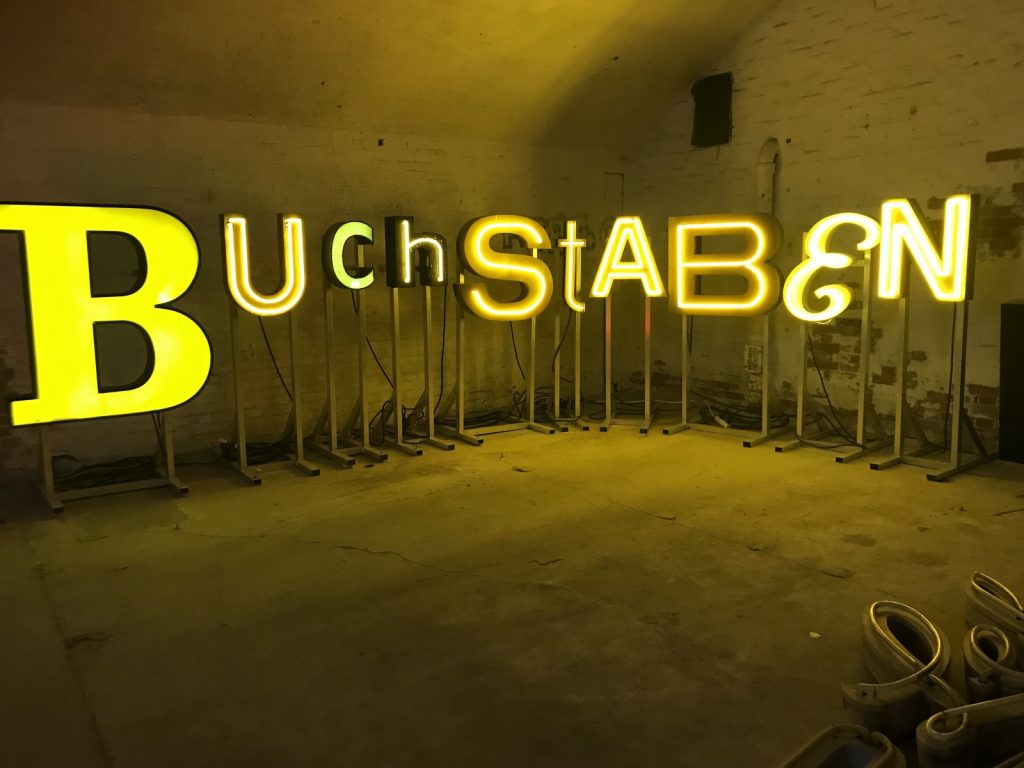
In dieser sehr angenehmen Atmosphäre hielten sich schon Kimya Gandhi und Rob Keller bereit, um ihren Vortrag zu halten. Die beiden waren aus Mumbai angereist, um zu erzählen, wie sie die Idee des Berliner Typostammtischs dort hatten etablieren wollen. Unter der Leitfrage „Kann man Typostammtisch übersetzen?“ berichteten beide von den Herausforderungen, das Berliner Format in die Welt, genauer nach Mumbai in Indien, zu tragen. Der Austausch, die Freundschaftlichkeit, das lockere Get-together – all dies, was sie am Berliner Typostammtisch so schätzen, hatte Rob und Kimya bis zuletzt in Mumbai gefehlt. Striktere Arbeitszeiten verbunden mit langen Fahrtzeiten innerhalb der sehr großen Stadt Mumbai lassen wenig Möglichkeit, sich nach Feierabend im Rahmen eines Typostammtischs zusammenzusetzen.
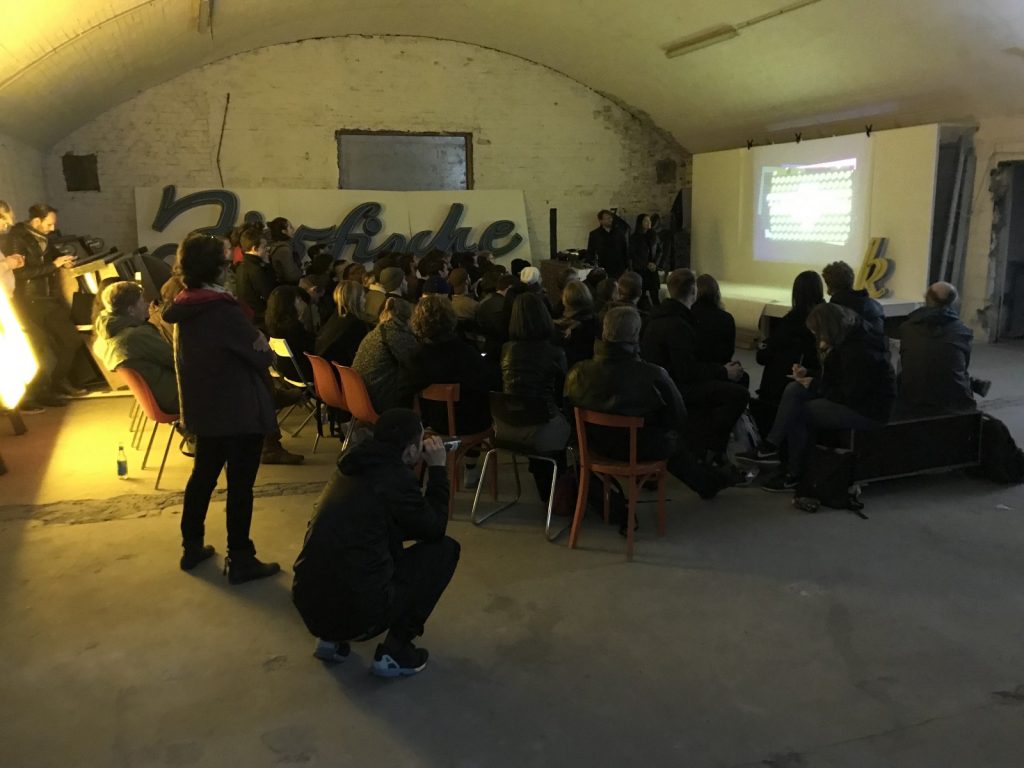
Ungeachtet dieser Umstände machten es sich Rob und Kimya zur Aufgabe, die mumbaische Typo-Szene monatlich unter ein Dach zu bekommen. Nach ersten Anläufen, bei denen sich doch immer mehr Teilnehmer zusammenfanden, hatte sich nach einigen Monaten das Format herausgebildet. Die Zusammensetzung der Treffen vorrangig aus Studenten bot viel Gelegenheit zum Austausch über Projekte und neue Techniken. Nach einiger Zeit und viel Arbeit hatte sich so in Mumbai der Typostammtisch aufgebaut, der für die nicht unbedeutende Typo-Szene der Stadt und des Landes den Austausch untereinander und international angeregt hat. Ob Vorträge, Type Crits, gemütliches Buchstabengucken: Rob und Kimya haben ohne Zweifel ihre Ziele erreicht, einen sozialen Austausch und eine entsprechende Plattform herzustellen. Eine unvorhergesehene Herausforderung war dabei die Getränkeversorgung: Wo bei Berliner Typostammtischen doch immer fleißig die Bar in Betrieb ist, war bei unserer indischen Schwester (wie diverse Fotos der Treffen in Mumbai belegten) Kimya die einzige, die mit einem kalten Bier umherlief. Ob die wohl doch sehr deutsche Idee „Stammtisch“ sich in Indien in dieser Form durchsetzen wird?
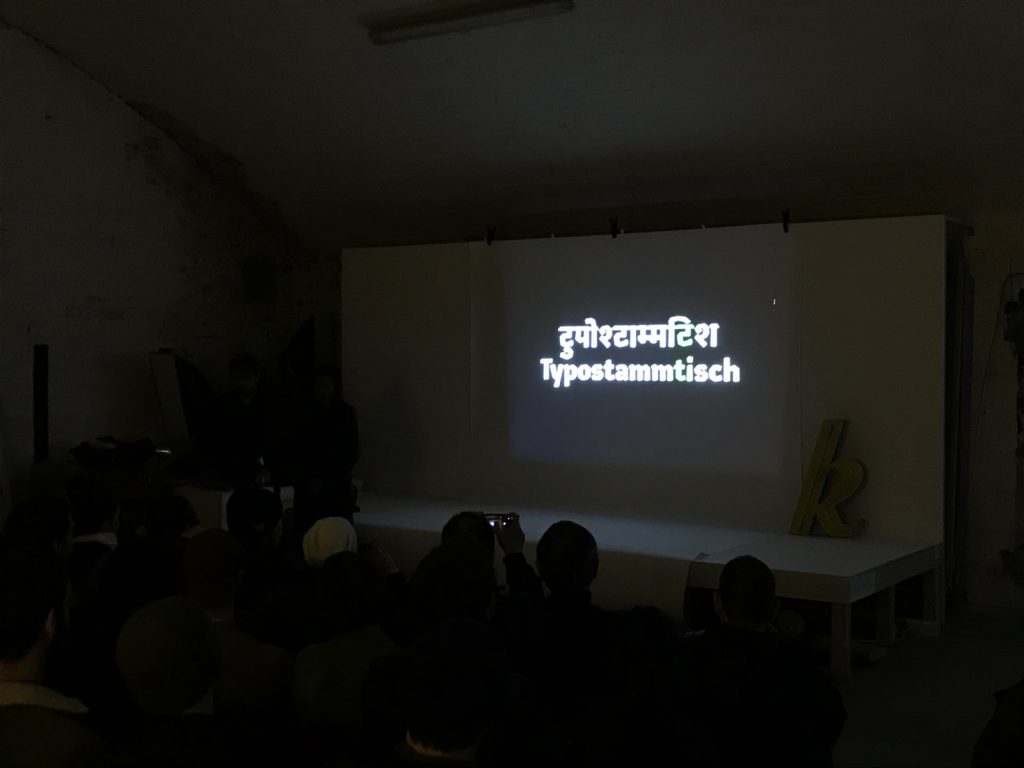
Nach der Präsentation und der Beantwortung der Publikumsfragen konnte das Buchstabenmuseum erkundet werden. Die vielen neuen Typostammtischgäste ebenso wie unsere langjährigen Typostammtischstammgäste (TStTStG) schlenderten staunend durch die magischen Katakomben und bewunderten buchstäblich tonnenweise Leuchtkastenbuchstaben. Der angenehme Ausklang inmitten einer Welt voller riesiger Buchstaben hätte schöner nicht sein können und rundete den Abend ideal ab. Als Einstimmung auf die folgenden drei Tage bei Berlin Letters war das Museum mit seinem riesigen Fundus an Inspiration kaum zu überbieten!
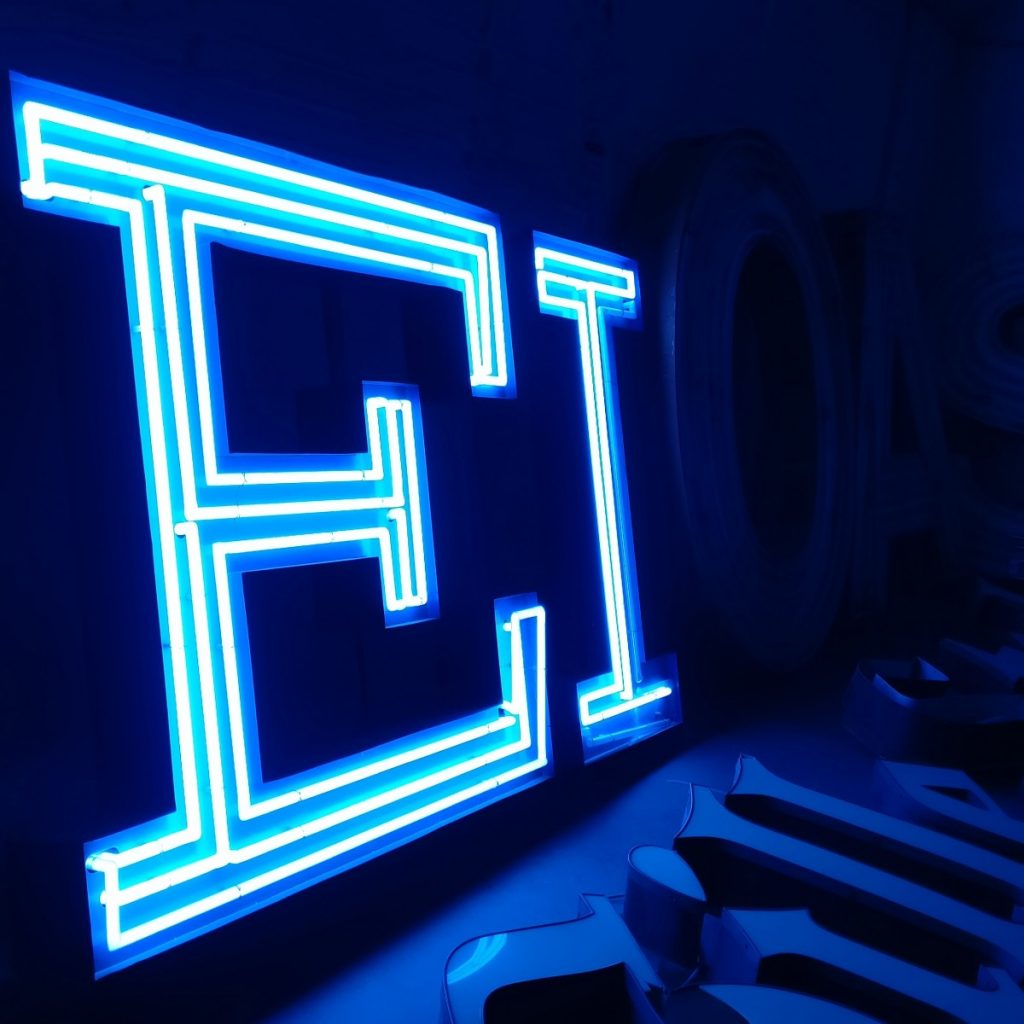
Das Buchstabenmuseum feierte am Folgetag seine offizielle Eröffnung. Ein Besuch in den S-Bahn-Bögen in Moabit kann nicht ausdrücklich genug empfohlen werden. Geöffnet hat das Buchstabenmuseum donnerstags bis sonntags von 13 bis 17 Uhr; im kleinen integrierten Shop findet man ausgewählte Buchstabengeschenke. Führungen speziell für Gruppen gibt es auf Anfrage: Mail an visit@buchstabenmuseum.de. Wer diese großartige kultur- und stadtgeschichtliche Institution unterstützen möchte, kann vor Ort oder online Mitglied werden. Eine Mitgliedschaft im Buchstabenmuseum beginnt mit 26 Euro im Jahr, für jeden Buchstaben im Alphabet einer (und der Mindestbetrag dessen, was man als Spende steuerlich absetzen kann). Auch einmalige Spenden in beliebig höherer Höhe werden gern entgegengenommen und dringend benötigt. Denn das kolossale Archiv wird momentan ausschließlich von Eintrittsgeldern, Spenden und eben den Mitgliedsbeiträgen getragen: buchstabenmuseum.de/
Aktuell erhält das Buchstabenmuseum keine Fördergelder und ist auf der Suche nach Sponsoren, mit denen zusammen eine dauerhafte Ausstellung aufgebaut und realisiert werden kann. Jede Unterstützung hilft. Wer möchte kann jederzeit ehrenamtlich mitwirken oder eben Mitglied werden, um an der weiteren Entwicklung beteiligt zu sein – einfach das Team vom Buchstabenmuseum kontaktieren.
Zum Weiterlesen über Hintergründe und Historisches, mit vielen Bildern zu durchaus dramatischen Buchstabenbergungen, Umzügen, kleinen Unfällen und fröhlichen Zusammenkünften (auch zu einem Typostammtisch bereits) an früheren Standorten des Buchstabenmuseums: Große Buchstaben, große Liebe von Sonja Knecht.
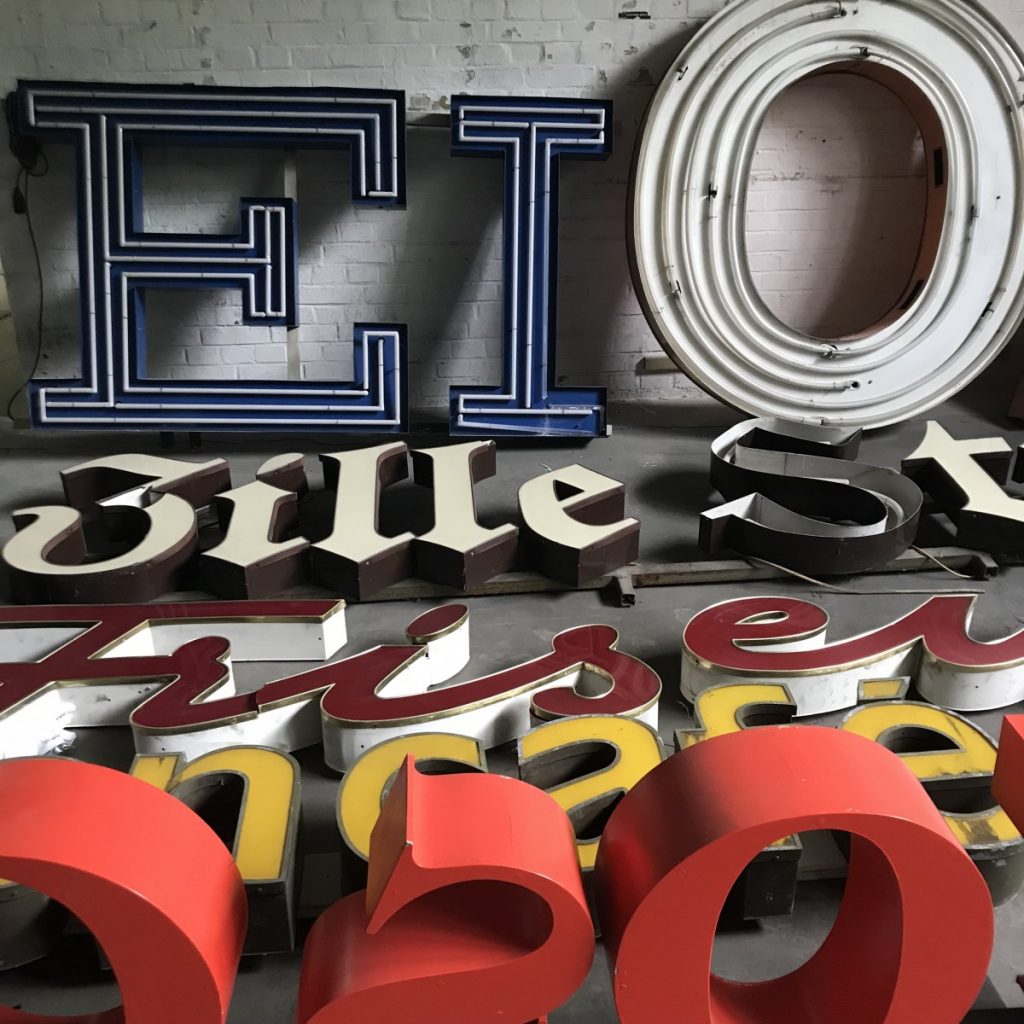
Für die Organisation und Bereitstellung dieser exklusiven Location danken wir ganz herzlich Barbara Dechant und Till Kaposty-Bliss vom Buchstabenmuseum, die uns einen unvergesslichen Abend ermöglichten.
///
After what felt like an eternity, the Buchstabenmuseum Berlin opened its doors again for the first time on 15 May 2019. Made possible in great part by the many helpful volunteers, who helped with tasks such as letter cleaning and other renovations over the past weeks and months, the team from the Buchstabenmuseum was able to offer its unique location to us for the May edition of the Typostammtisch – one day before its official opening.
Not only the location was exclusive this time around, the date also had a special significance: in past years, the conference TYPO Berlin took place in May; now (and hopefully for many years to come) the Festival Berlin Letters has taken care of the now empty primetime spot. In good tradition, the Typostammtisch took place the evening before as a prelude.
In spite of the somewhat chilly temperatures, which hardly became more pleasant in the halls of the Buchstabenmuseum in the S-Bahn arches in Moabit, about 70 guests joined us for the evening – just enough to find a seat for all of them. For the presentation of the evening, we gathered in the rearmost of the halls; on the way there, everyone could first marvel at the huge fluorescent tube wall with the Cyrillic version of the Coca-Cola logotype at the entrance and then make their way through the huge collection in awe: well-known signs from past times, or letters, whose affiliation one recognizes only at second glance, but also all sorts of curiosities and small treasures of Berlin letter history. Some of the neon tubes are even in operation, so that here and there letters shine in the darkness and contribute to the already magical atmosphere. In short, a never-ending source of inspiration for all of us. Once back, the actual event of the evening was waiting for us.
Kimya Gandhi and Rob Keller were primed and ready to give their lecture in this very pleasant atmosphere. The two had travelled from Mumbai to tell how they had wanted to establish the idea of the Berlin Typostammtisch there. Under the central question „Can you translate the Typostammtisch?“, both reported on the challenges of bringing the Berlin format into the world, more precisely to Mumbai in India. The exchange, the friendship, the relaxed get-together – all that they value so much about the Berlin Typostammtisch, Rob and Kimya had been missing in Mumbai until most recently. Stricter working hours combined with long travel times within the very large city of Mumbai leave little room for meeting for a Typostammtisch after work.
Regardless of these circumstances, Rob and Kimya made it their business to get the Mumbai typo scene together once every month. After the first attempts, in which more and more participants came together, the format had established itself after a few months. The attendees, mainly students, offered a lot of opportunity for exchange about projects and new techniques. After some time and a lot of effort, the Typostammtisch had established itself in Mumbai, which stimulated the exchange among each other and internationally for the rather significant type scene of the city and the country. Be it lectures, type crits, or a cozy look at the letters: Rob and Kimya have undoubtedly achieved their goals of creating a social exchange and a corresponding platform. An unforeseen challenge was the supply of drinks: While the bar is always busy at Berlin type regulars‘ tables, Kimya was the only one running around with a cold beer at our Indian partner event (as various photos of the meetings in Mumbai showed). Whether the probably nevertheless very German idea „Stammtisch“ will assert itself in India in this form?
After the presentation and the answering of the audience’s questions the Buchstabenmuseum was now open to be explored. The many new Typostammtisch guests as well as our long-time attendees strolled in awe through the magical catacombs and admired literally tons of lightbox letters. The pleasant conclusion in the middle of a world full of huge letters could not have been more beautiful. As a preparation for the following three days at Berlin Letters, the museum with its huge pool of inspiration was hard to beat!
The letter museum celebrated its official opening the following day. A visit to the S-Bahn arches in Moabit cannot be recommended explicitly enough. The Letter Museum is open Thursdays to Sundays from 1 p.m. to 5 p.m.; in the small integrated shop you will find selected letter gifts. Guided tours especially for groups are available on request: Mail to visit@buchstabenmuseum.de. If you would like to support this great cultural and historical institution, you can become a member at the Buchstabenmuseum in person or online. A membership in the Letter Museum starts at 26 Euros per year, one for each letter in the alphabet (and the minimum amount that can be tax deducted as a donation). One-off donations of any amount are also welcome and urgently needed. The colossal archive is at present financed exclusively by entrance fees, donations and the membership fees. buchstabenmuseum.de/unterstuetzen.
Currently, the Buchstabenmuseum does not receive any subsidies and is looking for sponsors with whom a permanent exhibition can be set up. Every bit of support helps. Anyone who would like to can volunteer at any time or become a member in order to be involved in further development – simply contact the Buchstabenmuseum team.
To read more about background and history, with many pictures of dramatic letter recoveries, location moves, small accidents and happy gatherings (we even once had a Typostammtisch) at former locations of the Buchstabenmuseum: Große Buchstaben, große Liebe of Sonja Knecht.
We would like to thank Barbara Dechant and Till Kaposty-Bliss from the Buchstabenmuseum for the organisation and provision of this exclusive location, which made this unforgettable reality for us.